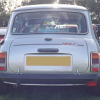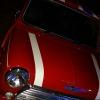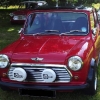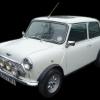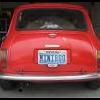
Cylinder Head removal/refitting
#1

Posted 26 September 2006 - 03:00 PM
I have got HBOL but i always like to check on here as a cross reference(and then ignore Haynes)
#2

Posted 26 September 2006 - 05:05 PM
its easy even a bungle can do it
ps just dont get your plug leads mixed up :'(
#3

Posted 26 September 2006 - 05:58 PM
1. Disconnect the earthstrap / negative terminal from the battery.
2. Remove the bonnet, after first marking the fitted position of the hinges to facilitate alignment when refitting.
3. Drain the cooling system by removing the cylinder block drain plug and/or disconnecting the bottom hose at the radiator.
4. Disconnect the HT leads from the plugs, after suitably labelling them to ensure correct positioning on reassembly. Also disconnect the lead from the water temperature gauge sender unit at the thermostat housing.
5. Disconnect the breather hose (where fitted) from the rocker cover, and remove the air cleaner assembly.
6. Disconnect the distributor vacuum pipe, fuel hose and engine breather pipe (where fitted) from the carburettor. On automatic models, also disconnect the kick-down linkage rod from the carburettor.
7. Disconnect the throttle return spring from the carburettor. Remove the two nuts securing the carburettor to the inlet manifold, detach the carburettor from the studs and place it to one side. Where a cable abutment plate is fitted between the carburettor and the inlet manifold, the plate should be removed with the carburettor.
8. Remove the two nuts securing the heater water control valve, detach the valve and place it to one side with the hose and cable still attached.
9. Remove the nuts securing the radiator upper support bracket to the thermostat housing, and the bolts securing it to the radiator cowl, and remove the bracket.
10. Slacken the clip securing the small by-pass hose to the cylinder head connection, this is located on the underside of the cylinder head, above the water pump.
11. Remove the two nuts, together with their cup washers and seals, retaining the rocker cover, and lift off the cover and gasket. 12. On 1275 GT models, remove the additional securing bolt 'A' and nut 'B' at the ends of the cylinder head.
13. Remove the cylinder head and rocker shaft pedestal nuts, releasing them evenly until the valve spring load on the rocker shaft assembly is released.
14. On models where the ignition coil mounting bracket is attached to one of the cylinder head studs, remove the coil and place to one side.
15. Lift off the rocker shaft assembly, then withdraw the pushrods, keeping them in their installed order.
16. Disconnect the radiator top hose from the thermostat housing.
17. Lift off the cylinder head, complete with the exhaust manifold. If difficulty is encountered in removing the head, tap each side of the head with a hide-faced mallet to free it.
18. Remove the cylinder head gasket and discard it.
Installation
Installation is a reversal of the removal procedure, with special attention to the following points.
a) Ensure that all joint surfaces, especially the mating surfaces of the cylinder head and block, are perfectly clean and free from old gasket material.
b ) If the cylinder head was removed to replace a leaking or blown head gasket, check the mating faces on both the head and block for distortion before reassembly.
c) Use new gaskets where appropriate. A cylinder head gasket set should be obtained, as this will contain all the necessary gaskets.
d) Do not use grease or jointing compound of any type on the cylinder head gasket when fitting.
e) Ensure the head gasket is correctly positioned. The gasket is normally marked 'TOP' and 'FRONT'.
f) Ensure that the push rods are installed in their original positions. Dip the ends of the rods in clean engine oil prior to installing them.
g) When fitting the rocker shaft assembly, ensure that the rocker arm adjusting screws locate correctly in the cupped end of their respective push rods. If any work has been carried out on the valves (e.g. recutting the valve seats) the rocker arm adjusting screws should be released slightly before installing the rocker shaft assembly. Lubricate the rocker assembly with clean engine oil.
h) Tighten the cylinder head and rocker shaft pedestal nuts evenly, following the sequence shown in. The cylinder head nuts should be tightened in stages (see haynes manual)
[attachment=20061:attachment]
i) On models which have the ignition coil bracket attached to one of the cylinder head studs, do not forget to refit the bracket before fitting and tightening the head nuts.
j) On 1275 GT models, the additional securing bolt 'A' and nut 'B' must be tightened last. These should be tightened to (see haynes manual)
k) Check the valve clearances, as described previously, and adjust if necessary.
l) When installation is complete, refill the cooling system, then run the engine and check for oil, water or exhaust leaks.
Edited by 1984mini25, 26 September 2006 - 05:59 PM.
#4

Posted 25 October 2016 - 06:18 PM
attachment
1. Disconnect the earthstrap / negative terminal from the battery.
2. Remove the bonnet, after first marking the fitted position of the hinges to facilitate alignment when refitting.
3. Drain the cooling system by removing the cylinder block drain plug and/or disconnecting the bottom hose at the radiator.
4. Disconnect the HT leads from the plugs, after suitably labelling them to ensure correct positioning on reassembly. Also disconnect the lead from the water temperature gauge sender unit at the thermostat housing.
5. Disconnect the breather hose (where fitted) from the rocker cover, and remove the air cleaner assembly.
6. Disconnect the distributor vacuum pipe, fuel hose and engine breather pipe (where fitted) from the carburettor. On automatic models, also disconnect the kick-down linkage rod from the carburettor.
7. Disconnect the throttle return spring from the carburettor. Remove the two nuts securing the carburettor to the inlet manifold, detach the carburettor from the studs and place it to one side. Where a cable abutment plate is fitted between the carburettor and the inlet manifold, the plate should be removed with the carburettor.
8. Remove the two nuts securing the heater water control valve, detach the valve and place it to one side with the hose and cable still attached.
9. Remove the nuts securing the radiator upper support bracket to the thermostat housing, and the bolts securing it to the radiator cowl, and remove the bracket.
10. Slacken the clip securing the small by-pass hose to the cylinder head connection, this is located on the underside of the cylinder head, above the water pump.
11. Remove the two nuts, together with their cup washers and seals, retaining the rocker cover, and lift off the cover and gasket. 12. On 1275 GT models, remove the additional securing bolt 'A' and nut 'B' at the ends of the cylinder head.
13. Remove the cylinder head and rocker shaft pedestal nuts, releasing them evenly until the valve spring load on the rocker shaft assembly is released.
14. On models where the ignition coil mounting bracket is attached to one of the cylinder head studs, remove the coil and place to one side.
15. Lift off the rocker shaft assembly, then withdraw the pushrods, keeping them in their installed order.
16. Disconnect the radiator top hose from the thermostat housing.
17. Lift off the cylinder head, complete with the exhaust manifold. If difficulty is encountered in removing the head, tap each side of the head with a hide-faced mallet to free it.
18. Remove the cylinder head gasket and discard it.
Installation
Installation is a reversal of the removal procedure, with special attention to the following points.
a) Ensure that all joint surfaces, especially the mating surfaces of the cylinder head and block, are perfectly clean and free from old gasket material.
b ) If the cylinder head was removed to replace a leaking or blown head gasket, check the mating faces on both the head and block for distortion before reassembly.
c) Use new gaskets where appropriate. A cylinder head gasket set should be obtained, as this will contain all the necessary gaskets.
d) Do not use grease or jointing compound of any type on the cylinder head gasket when fitting.
e) Ensure the head gasket is correctly positioned. The gasket is normally marked 'TOP' and 'FRONT'.
f) Ensure that the push rods are installed in their original positions. Dip the ends of the rods in clean engine oil prior to installing them.
g) When fitting the rocker shaft assembly, ensure that the rocker arm adjusting screws locate correctly in the cupped end of their respective push rods. If any work has been carried out on the valves (e.g. recutting the valve seats) the rocker arm adjusting screws should be released slightly before installing the rocker shaft assembly. Lubricate the rocker assembly with clean engine oil.
h) Tighten the cylinder head and rocker shaft pedestal nuts evenly, following the sequence shown in. The cylinder head nuts should be tightened in stages (see haynes manual)attachment
i) On models which have the ignition coil bracket attached to one of the cylinder head studs, do not forget to refit the bracket before fitting and tightening the head nuts.
j) On 1275 GT models, the additional securing bolt 'A' and nut 'B' must be tightened last. These should be tightened to (see haynes manual)
k) Check the valve clearances, as described previously, and adjust if necessary.
l) When installation is complete, refill the cooling system, then run the engine and check for oil, water or exhaust leaks.
I want to remove my head to inspect the bores and Pistons it's a brand new engine that I have bought but don't have a spec lift but would like to have a look. Should I replace the head studs after I've taken the head off shouldn't be long off maybe half a day? Do I need a new head gasket as well?.
Cheers,
Jordan
#5

Posted 25 October 2016 - 06:55 PM
Well documented, but no mention of moving the exhaust manifold back to clear the studs, which involves either undoing the bottom fixings if it is a tubular (i.e.LCB or 3-into-1) type, or undoing the horrible clamp if it is a cast manifold.
However, a good tip when re-fitting is to remove the studs in the head and replace them with 5/16" UNF x 1.25" long hexagon head screws. With that done head removal is just so simple in the future. No need to undo the carb or any of its linkages, no need to do anything with the exhaust. Just undo the top engine steady, remove the 5/16" UNF screws and once the other odds and ends are removed (rocker shaft, etc, just lift the head straight off. That is how Ford did it with the Cortina and Escort which were built during the Mini era. I can change the head gasket on my Cooper 'S' in around an hour if necessary.
#6

Posted 25 October 2016 - 07:11 PM
Well documented, but no mention of moving the exhaust manifold back to clear the studs, which involves either undoing the bottom fixings if it is a tubular (i.e.LCB or 3-into-1) type, or undoing the horrible clamp if it is a cast manifold.
However, a good tip when re-fitting is to remove the studs in the head and replace them with 5/16" UNF x 1.25" long hexagon head screws. With that done head removal is just so simple in the future. No need to undo the carb or any of its linkages, no need to do anything with the exhaust. Just undo the top engine steady, remove the 5/16" UNF screws and once the other odds and ends are removed (rocker shaft, etc, just lift the head straight off. That is how Ford did it with the Cortina and Escort which were built during the Mini era. I can change the head gasket on my Cooper 'S' in around an hour if necessary.
That's what I was planning on doing with mine (thanks for the required bolt sizes), can't be bothered having to mess around with the exhaust manifold etc, seperating the exhaust from the lcb and ball ache stuff like that
#7

Posted 24 February 2019 - 09:16 AM
Well documented, but no mention of moving the exhaust manifold back to clear the studs, which involves either undoing the bottom fixings if it is a tubular (i.e.LCB or 3-into-1) type, or undoing the horrible clamp if it is a cast manifold.
However, a good tip when re-fitting is to remove the studs in the head and replace them with 5/16" UNF x 1.25" long hexagon head screws. With that done head removal is just so simple in the future. No need to undo the carb or any of its linkages, no need to do anything with the exhaust. Just undo the top engine steady, remove the 5/16" UNF screws and once the other odds and ends are removed (rocker shaft, etc, just lift the head straight off. That is how Ford did it with the Cortina and Escort which were built during the Mini era. I can change the head gasket on my Cooper 'S' in around an hour if necessary.
Digging up an old post here, but about to remove the head on mine and thought I'd search for some useful tips (I've done the job multiple times in the past, but the last time was over 10 years ago, so feeling a little rusty). I like the long bolts into the head - any reason for not doing this? Also, any links to where I could purchase some from?
Thanks
Luke
#8

Posted 24 February 2019 - 09:28 AM
The other thing that wasn't mentioned in 1984Mini's detailed list, is to undo the cylinder head studs in a spiral fashion, starting at thermo housing end front and ending at the middle front, initially maybe one turn of the nut at a time, and then the reverse during assembly ensuring they are all torqued down evenly to 60lbs/ft (80Nm)
#9

Posted 24 February 2019 - 12:47 PM
why is it always the last one (stud) that won't come out ![]()
Looks like I'm now gonna have to remove the manifold (its a freeflow type)
#10

Posted 24 February 2019 - 12:54 PM
It's worthwhile replacing the manifold studs with bolts. So if there's a next time you don't need to take the manifold off to get the head off with the head studs in place. Makes changing the manifold gasket easier too.
#11

Posted 24 February 2019 - 12:58 PM
It's worthwhile replacing the manifold studs with bolts. So if there's a next time you don't need to take the manifold off to get the head off with the head studs in place. Makes changing the manifold gasket easier too.
Will do, once i get the bugger out!
can't see any on minispares to purchase...anywhere else?
#12

Posted 24 February 2019 - 02:12 PM
I got these
https://www.ebay.co....em=382794292084
You may need to shorten them a bit depending on how thick your washers are. With the thick washers, and a spring washer, shown here they were the right length

Edited by panky, 24 February 2019 - 02:13 PM.
0 user(s) are reading this topic
0 members, 0 guests, 0 anonymous users





